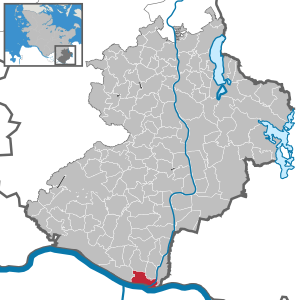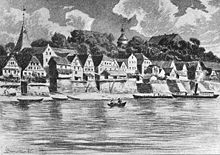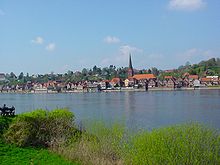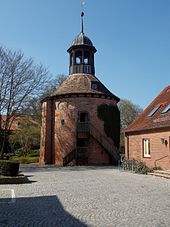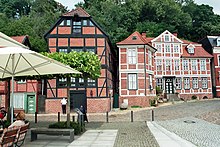Lauenburg / Elbe
| coat of arms | Germany map | |
|---|---|---|

|
Coordinates: 53 ° 22 ' N , 10 ° 33' E |
|
| Basic data | ||
| State : | Schleswig-Holstein | |
| Circle : | Duchy of Lauenburg | |
| Height : | 49 m above sea level NHN | |
| Area : | 9.54 km 2 | |
| Residents: | 11,402 (Dec 31, 2019) | |
| Population density : | 1195 inhabitants per km 2 | |
| Postal code : | 21481 | |
| Area code : | 04153 | |
| License plate : | RZ | |
| Community key : | 01 0 53 083 | |
| LOCODE : | DE LNU | |
City administration address : |
Amtsplatz 6 21481 Lauenburg / Elbe |
|
| Website : | ||
| Mayor : | Andreas Thiede ( independent ) | |
| Location of the city of Lauenburg / Elbe in the Duchy of Lauenburg district | ||
Lauenburg / Elbe ( Low German : Loonborg ) is a small town in the Duchy of Lauenburg in Schleswig-Holstein . The southernmost city of Schleswig-Holstein is located about 40 km southeast of Hamburg on the Elbe in the triangle of Schleswig-Holstein, Lower Saxony and Mecklenburg-Western Pomerania .
geography
Lauenburg is located on the northern right bank of the Elbe, which forms the border between Schleswig-Holstein and Lower Saxony . The Elbe-Lübeck Canal branches off in the urban area , about three kilometers to the west (in Artlenburg in Lower Saxony ) the Elbe Lateral Canal . To the southeast of Lauenburg is the border triangle Schleswig-Holstein - Lower Saxony - Mecklenburg-Western Pomerania .
The hiking trail north of the Elbe leads to the former mouth of the Möllner meltwater channel in the glacial valley of the Elbe. Here the ridge of the Geest rises around 68 m above the Elbe lowlands. Over time, the Elbe has formed a high steep bank here .
Naming
The name Lauenburg was originally "Polabenburg" and referred to the castle that Bernhard von Askanien built in the land of the Slavic tribe of the Polabians (residents on the Elbe, old Slavic Labe) in 1181/1182 and after which the city and the country themselves were later named were.
history
founding
What is certain is that Lauenburg already had town charter in 1260. The city of Lauenburg therefore celebrated its 700th birthday in 1960 based on a document from 1260.
On the other hand, according to his more recent research, Wichmann von Meding assumes that the city was founded by the Danes in 1209. They had under King Canute VI. seized the counties of Holstein and Ratzeburg and in 1199 Lauenburg, which was previously in the hands of the Welfs. Older sources indicate that Duke Albrecht I wanted to build a town below the castle after the victory at Bornhöved (1227). The first pastor of the church was first mentioned in 1243. The city charter Lauenburg received before the year 1260th
Duchy
Lauenburg was a duchy until 1689 , whereby the area of the old duchy largely coincides with today's district of the Duchy of Lauenburg . In the Middle Ages, Lauenburg was an important trading point on the Stecknitz Canal , which branched off from the Elbe here. The old salt road crossed the Elbe four kilometers west below the Ertheneburg near Schnakenbek .
In 1635 the Skipper Brotherhood was founded, originally an association of skippers and ship servants who were based in the city of Lauenburg. It still exists today and celebrates the Schipperhöge festival every January with a parade through the city.
On June 10, 1666, the Lauenburg rifle guild, which still exists today, was founded.
French time
After the Artlenburg Convention , the Duchy of Lauenburg was occupied by French troops and incorporated into the French Empire from 1810 to 1813 and added to the Département des Bouches de l'Elbe . In the battle for Lauenburg on the western outskirts of Lauenburg on August 17 and 19, 1813, allied troops fought against the Napoleonic units under Marshal Davout advancing from Hamburg .
Prussian time
In 1865, after the German-Danish War , with the Treaty of Gastein, Schleswig became part of Prussia, Holstein joined Austria, and Lauenburg again became part of Prussia.
On February 18, 1872, the three suburban communities Unterberg, Hohlenweg and Oberbrücke were united with the city of Lauenburg.
National Socialist Period
From 1934 to 1940 Kurt Petersen , lawyer and NSDAP member, was mayor of Lauenburg. In 1934 civil air raid protection was also established in Lauenburg . During the Second World War , the city was largely spared from destruction. Allied planes often flew over Lauenburg on the way to Hamburg, but they did not drop any bombs. In 1941 there was only one attack on the local electricity company .
Germany lost World War II in 1945 and it was gradually occupied. In the last days of the war, the Allied troops moved further and further north. The Wehrmacht retreated north across the Elbe. Preparations for the expected fighting began in April in the Duchy of Lauenburg. Positions, foxholes, trenches and anti-tank traps equipped with mines were established. In addition, various bridges were prepared for blasting. German pioneers then blew up the Lauenburg Elbe Bridge on April 19 . At this point in time, British armed forces were already standing on the opposite side of the Elbe from Lauenburg near Hohnstorf and Sassendorf . The British troops crossed the Elbe in the night of April 28-29 , 1945 near Artlenburg and Schnakenbek . Lauenburg was taken the following morning. Then they advanced west towards the dynamite factory Krümmel and Geesthacht , where war gas was stored. To the north they reached Lübeck on May 2, 1945. On the same day, the executive government of the Reich fled from the Eutin - Plön area from the approaching British troops to Flensburg - Mürwik . Only two days later, all German troops in northwest Germany, the Netherlands and Denmark were finally capitulated .
Lauenburg in Schleswig-Holstein
In 1951 the new bridge over the Elbe was completed. On March 12, 1953, a Soviet MiG-15 shot down a British military aircraft on the Elbe near Lauenburg near the border with the GDR .
Lauenburg has been part of the Hamburg metropolitan region since 1995 . On May 25, 2009, the city received the title “ Place of Diversity ” awarded by the federal government .
Denomination statistics
As of January 1, 2018, 37.2% of the population were Protestant and 5.6% Roman Catholic . 57.2% belonged to other denominations or religious communities or were non-denominational .
politics
City council and mayor
The election for the city council on May 6, 2018 resulted in the following distribution of seats with a voter turnout of 36.6% (with a difference to the 2013 election):
| Party / list | Seats | +/- |
| CDU | 7th | - 1 |
| SPD | 7th | - 2nd |
| Alliance 90 / The Greens | 3 | ± 0 |
| FDP | 1 | ± 0 |
| Lauenburg voter community (LWG) | 5 | + 3 |
Mayor has been Andreas Thiede (CDU) since 2011. On November 27, he was confirmed in office with 86.8 percent of the votes cast and took up his new term on April 1, 2017.
coat of arms
Blazon : “A red castle in silver with a golden gate in the wall and two pointed tin towers; between them a split shield hovering: in front in silver half a red eagle at the crack, behind nine times divided by black and gold, covered with angled, curved green diamond wreath. "
Alternatively, the main statute of the city says: "The coat of arms of the city of Lauenburg / Elbe shows two red crenellated towers with a pointed, blue roof in silver above a red battlement wall with a closed golden gate, between which a split shield hovers, the right in Silver shows half a gold-armored, red eagle at the slit and which is divided ten times by black and gold on the left, covered by a diagonal, green diamond wreath. "
Administrative community
Lauenburg / Elbe manages the administrative business of the Lütau district as part of an administrative community .
Town twinning
- Boizenburg / Elbe (Mecklenburg-Western Pomerania)
- Lębork (Lauenburg / Pomerania)
- Dudelange (Luxembourg)
- Manom (France)
Sponsorships
On May 5, 1960, the city of Lauenburg took over the sponsorship of the Elbe tender of the German Navy. With the commissioning of the new Elbe tender in 1992, this tradition was continued.
Culture and sights
Old town
The city has a beautiful old town. The Palm lock , the oldest preserved boiler lock in Germany , is located near the beginning of the old Stecknitz Canal . The Maria Magdalenen Church , which was founded around 1220 and is a significant architectural monument from the 13th century, is also worth seeing . The remains of Lauenburg Castle can be found on the Schlossberg .
The Künstlerhaus Lauenburg is located in the old town , an international scholarship holder of the State of Schleswig-Holstein under the patronage of the Ministry of Culture. Around 120 scholarships have been awarded over the past 26 years. Attached to the Künstlerhaus is the Stadtgalerie Lauenburg im Hagenström , where the works of the scholarship holders can be exhibited or read and heard.
In Lauenburg's old town, numerous artists and artisans also have their studios or exhibition rooms, such as Alexander Rantzau (Mex4art gallery), Susanna Anthöfer, Fritz Schade or Christian Kleinfeld.
Museums
The Elbe Shipping Museum is dedicated to shipping from above Hamburg to Bohemia in a historic building in the lower town of Lauenburg.
The paddle steamer Kaiser Wilhelm , built in Dresden in 1899/1900, is one of the last coal-fired ones in Germany. It is maintained and operated on a voluntary basis by the Association for the Promotion of the Lauenburger Elbschiffahrtmuseum e. V.
The highest landmark of the city is the mill museum Lauenburger Mühle from 1871/1873, a Dutch gallery mill . From here you have a good overview of the city as well as Mecklenburg and Lower Saxony. The process of making flour from grain is illustrated here.
Sports
The largest sports club in Lauenburg is the Lauenburg sports association with the sports badminton, soccer, handball, chess, gymnastics, table tennis and marching band. The best-known team, which also has the highest ranking in terms of the league, is the first woman in handball, which plays under the name Elbdiven in the Hamburg / Schleswig-Holstein major handball league.
The Ruder-Gesellschaft Lauenburg e. V. was able to provide German, European and world champions in the 1960s, as well as an Olympic gold and silver medal. Recently, a Lauenburger was able to become German junior champion in the Schleswig-Holstein four.
graveyards
- On the western outskirts in a wood on Bundesstraße 5 there is a war cemetery with fallen soldiers from the Second World War.
- The Lauenburg cemetery at the intersection between B 5 and B 209 is laid out like a park and is maintained by the Lauenburg Evangelical Church.
Art in public space
Lauenburg has a rich collection of art in public spaces. A dozen partly large-format works, mainly by northern German artists of the 20th century, made of metal, stone or ceramics are distributed over the entire city area. The works of the sculptor and sculptor Karlheinz Goedtke are of particular importance . His most significant work for the city, which is counted among the landmarks of Lauenburg, is the bronze figure The Rufer on Ruferplatz in Elbstrasse. This was created and set up in 1959. Other bronze sculptures by this artist are on the square in front of the post office on Büchener Weg Die Waiting (1967), in front of the youth hostel the figure Hans im Glück (1953) and in front of the Albinus Community School the group international understanding (1964). It symbolically represents the continents of Europe, Asia, Africa, Australia and America. In addition, there is a colored ceramic relief with a bronze figure of the artist in the city and school library at Weingarten, which was originally created in 1959 for the facade of the Weingarten school.
The Elmshorn painter and sculptor Walter Arno is represented in Lauenburg with the metal relief Blown Sail (1986), which is on the premises of the Waterways and Shipping Office.
The bronze sculpture Ich bin (1995) by Edith Breckwoldt is located at Askanierblick in front of the official building on the Schlossberg .
Next to the entrance to the youth hostel in the match factory is the sculpture Die Streichhölzer , which was created in the 1990s by scholarship holders of the Künstlerhaus on behalf of the Friedrich Naumann Foundation .
The large sculpture Graniticum XV by the Büchen artist Ludwig Vöpel in the form of a steel pyramid with a granite boulder on its tip stands on the discharge and loading area of the port . The subtitle of the sculpture is Alter Schwede in Lauenburg , an allusion to the origin of the 56 hundredweight boulder. The artist sees the combination of steel and granite as a “symbol for time and eternity”.
At the entrance to the Alte Wache there is the Lauenburg Lion Fountain with a replica of a lion statue that was created around 1600. The lion bears the coat of arms of Duchess Maria, wife of Duke Franz II of Lauenburg (1581–1619). It is said to have been attached to the city's west gate, which was demolished in 1823. According to other sources, the lion statue comes from the Ascanian castle. After the original fell victim to an act of vandalism in 2009, it was restored and has been in the lapidarium of the castle tower since then, while a true-to-original replica can be found on the fountain.
Interglacial peat storage
From the end of the last interglacial period, a peat camp from the Eem warm period was built on Oberstleutnantsweg am Elbkamp .
economy
Established businesses
- Hitzler shipyard
- MEWA textile management
- Waterways and Shipping Office
- Smurfit Kappa Wellpappe Nord GmbH Lauenburg plant
- Worlée Chemie GmbH
education
In Lauenburg there is a community school with a special school center and an upper level leading to the Abitur, a primary school and a technical school for care for the elderly.
traffic
The federal road 209 and the Lübeck – Lüneburg railway line , where Lauenburg has a train station, run across the Lauenburg bridge over the Elbe .
The federal highway 5 , which runs in an east-west direction and runs right through the town, ensures a steady flow of trucks passing through the town center. To avoid the associated noise and environmental pollution, a bypass road has been planned for many years. However, the implementation of the project has not yet started (as of 2016) because the bypass road was not classified as an urgent need in the federal transport infrastructure plan .
VHH buses connect Lauenburg with Bergedorf and Hamburg via Geesthacht . An automatically driving minibus called "TaBuLa Shuttle" has been operating in Lauenburg as a test operation since October 2019. The offer is a research project of the Technical University of Hamburg and the Duchy of Lauenburg in cooperation with the VHH.
Lauenburg lies on a waterway cross. The Elbe flowing past connects the North Sea and Hamburg with the metropolitan areas of Berlin, Magdeburg, Leipzig / Halle, Dresden and Prague. The Elbe-Lübeck Canal , which branches off from the Elbe directly in the urban area, connects the Elbe with the Baltic Sea and the port of Lübeck over a length of 62 km. At the beginning of the canal, right behind the new lock designed for modern inland waterway vessels, is the Horster Damm port and, directly at the confluence with the Elbe, the Hitzler shipyard, a regionally important new build and repair shipyard. The Elbe Lateral Canal flows three kilometers down the Elbe and connects the Elbe with the West German canals and, regardless of the water level, with Berlin.
Lauenburg in literature
The writer Doris Runge wrote several poems about the city and the Elbe during her scholarship period in 1987/88. Here's the best known:
lauenburg / elbe
the day goes
loses the river
of gray eyes of the elbe
peaceful image
when the city
bleeds to death
with severed
veins
falls back into a
thousand-year
sleep
The Hamburg writer Carsten Klook , who lived and worked for six months as a scholarship holder in the Künstlerhaus Lauenburg, signed the novel Stadt here . Lauenburg serves as the backdrop for a crime story.
In his 2013 memoirs Papa, where are you from? The Lauenburg photographer, former CDU local politician and local journalist Horst Borutta describes his flight as a youth from Masuria to Lauenburg and dedicates a chapter to life in the Schifferstadt at the end of the 1950s.
The German author Uwe Friesel wrote a crime thriller in 1983 with the title Lauenburg Connection , which deals with drug smuggling across the Upper Elbe near Lauenburg to Berlin.
The former literature scholarship of Künstlerhaus Lauenburg Regine Kress Fricke wrote stories and poems about Lauenburg that in 2012 tick at their own pace in Pop Verlag have appeared (Germany).
Lauenburg in the film
In 2009, the two Berlin filmmakers David Betge and Urs Kind shot the 50-minute documentary film But the rest is beautiful here in Lauenburg, which premiered in January 2010 in Lauenburg's Osterwold Hall. The film was funded by the Strengths on Site program of the European Social Fund.
In 2012, some scenes for the film Banklady by Christian Alvart with Nadeshda Brennicke and Charly Hübner in the leading roles were shot in the original 1960s ambience of the Hotel Bellevue . The Hamburg director and author Claire Walka , who received a grant from the Künstlerhaus Lauenburg in 2010, shot a documentary about the Hotel Bellevue, which premiered in October 2014 at the Nordic Film Festival in Kiel.
The two-part TV series Die Sturmflut from 2006, which tells the story of the Hamburg storm surge on February 16, 1962, was partly filmed in Lauenburg. a. in the restaurant and guesthouse Zum Anker at the harbor, where a harbor ambience of the 1960s has been preserved that no longer exists in Hamburg.
In 1968 Wolfdietrich Schnurre shot a television adaptation of the novella Pole Poppenspäler by Theodor Storm u. a. with Walter Richter , Gerda Gmelin , Bruno Vahl-Berg and Joachim Wolff .
For the German silent film Nosferatu - A Symphony of Horror (1922) by Friedrich Wilhelm Murnau , several exterior shots were shot on the banks of the Elbe in the old town of Lauenburg.
Personalities
Former honorary citizen
- 1895 Otto von Bismarck , Reich Chancellor
sons and daughters of the town
- August Pfeiffer (1640–1698), Lutheran theologian, orientalist, devotional writer and superintendent of the city of Lübeck
- Ernst Christoph Hochmann von Hochenau (1670–1721), mystical pietist
- Jürgen Christian Findorff (1720–1792), peat colonizer
- Johann Dietrich Findorff (1722–1772), court painter and graphic artist for the Mecklenburg dukes
- Karl Ludwig Harding (1765–1834), astronomer
- Eberhard Berenberg (1776–1844), book printer owner
- Carl Erxleben (politician, 1814) (1814–1884), Finance Minister Kingdom of Hanover and member of the Reichstag
- Johannes Diermissen (1823-1893), Low German author and folklorist
- Franz Mützelfeldt (1866–1938), founder of the Mützelfeldtwerft
- Gustav Burmester (1904–1995), architect
- Jürgen Plagemann (* 1936), world and European champion, Olympic runner-up in 1964 in rowing (with the "Adam eighth")
- Edith Breckwoldt (1937–2013), sculptor and daughter of Lauenburg's major inland tanker shipowner Christoph Burmester
- Dirk Schreyer (* 1944), world and European champion, 1968 Olympic champion in rowing (with the "Adam eighth")
- Georgia Langhans (* 1947), politician and member of the Lower Saxony state parliament
- Birgit Küstner (* 1950), politician (SPD) and former member of the Schleswig-Holstein state parliament
- Christel Hildebrandt (* 1952), translator
- Claudia Schröder (* 1953), film producer
- Uwe Bahn (* 1958), moderator, photographer and author
- Manfred Krafft (* 1963), business economist and university professor
- Norbert Brackmann (* 1954), politician (CDU) and member of the German Bundestag
Other personalities
- Christian Friedrich Ludwig Albinus (1771–1837), customs officer, counselor, patron and philanthropist, founded a savings and loan bank in the Duchy of Lauenburg as well as a commercial and secondary school.
- Wilfried Baasner (1940–2006), German actor, spent childhood and youth in Lauenburg.
- Heinrich Burmester (1839–1889), Low German writer. Lived in Lauenburg in the 1880s until his suicide as a felt slipper maker.
- Julius Hackethal (1921–1997) worked from 1965 to 1974 in the Lauenburg Municipal Hospital.
- Markus Matthießen (* 1973), Schleswig-Holstein politician, member of the state parliament for the constituency of Lauenburg-Süd from 2009 to 2012
literature
- William Boehart: Lauenburg. Sutton, Erfurt 2000, ISBN 3-89702-210-9 .
- William Boehart, Heinz Bohlmann, Cordula Bornefeld, Christian Lopau: Between standstill and change: the special path of the Duchy of Lauenburg into the modern age. Ed .: William Boehart on behalf of the Heimatbund and history association Herzogtum Lauenburg e. V. , Viebranz, Schwarzenbek 2001, ISBN 3-921595-33-9 .
- Magistrate of the city (ed.): Chronicle of the city of Lauenburg / Elbe. WETA-Druck, Lauenburg 1993.
- Martin Kleinfeld: The economic development of the city of Lauenburg / Elbe from the 18th to the 20th century (= series of publications studies on historical research of the modern age. Volume 17). Publishing house Dr. Kovac, Hamburg 2000, ISBN 3-8300-0188-6 .
- Peter von Kobbe: History and description of the country of the Duchy of Lauenburg. Altona 1837
- Friedrich Lammert: The oldest history of the state of Lauenburg: from the beginnings to the victory at Bornhöved. Lauenburgischer Heimatverlag, Ratzeburg 1933.
- Wichmann von Meding: City without a country on the river: 800 years of European small town Lauenburg. Lang, Frankfurt am Main (inter alia) 2007, ISBN 978-3-631-55963-5 .
- Wichmann von Meding: Lauenburg - On the history of the place, office, duchy:…. Lang, Frankfurt am Main (among others) 2008, ISBN 978-3-631-57193-4 .
- Eckart Opitz: 800 years of Lauenburg? Critical comments on the granting of city rights in 1209 , in: Lauenburgische Heimat . Journal of the Heimatbund and history association Herzogtum Lauenburg. Volume 181, Ratzeburg 2009, pp. 3-15.
- Martin Kleinfeld: The history of the match industry in the city of Lauenburg / Elbe under the direction of the Großeinkaufsgesellschaft Deutscher Consumvereine mbH (GEG). Norderstedt 2010, ISBN 978-3-839-14507-4 .
Web links
Individual evidence
- ↑ North Statistics Office - Population of the municipalities in Schleswig-Holstein 4th quarter 2019 (XLSX file) (update based on the 2011 census) ( help on this ).
- ^ Christian Ernst Weisse: History of the Chursächsischen states. Volume 2, Leipzig 1803, pp. 206 and 207.
- ^ Eckart Opitz: 800 years of Lauenburg? Critical comments on the granting of city rights in 1209 , in: Lauenburgische Heimat. Journal of the Heimatbund- und Geschichtsverein Herzogtum Lauenburg. Volume 181, Ratzeburg 2009, pp. 3-15.
- ^ Hans-Georg Kaack: Ratzeburg: History of an island town. Wachholtz, Neumünster 1987, ISBN 3-529-02683-2
- ↑ S. Hirzel et al .: Research on German regional studies. German Academy for Regional Studies, Leipzig etc. 1940.
- ↑ William Boehard, Carsten M. Walczok: battle of Lauenburg 1813. sheet of of 2010.
- ^ Johannes Schmarje : The province of Schleswig-Holstein (= regional studies of Prussia. Issue 5). Wilhelm Spemann, Berlin / Stuttgart 1904, p. 63.
- ↑ National Day of Mourning. Schwarzenbeker memorial stones about war and persecution. Bunker in Lauenburg - evidence of the Second World War. (PDF) p. 5, dated: April 2012; accessed on: May 29, 2018.
- ^ A b Lübecker Nachrichten : Last fighting in spring 1945. April 14, 2015; accessed on: May 30, 2018.
- ^ 1945: How Lübeck escaped the final battle. In: Lübecker Nachrichten. May 8, 2010, p. 3.
- ↑ Kröppelshagen-Fahrendorf village newspaper. End of the war 70 years ago. P. 10, dated: spring 2015; accessed on: May 30, 2018.
- ↑ Lauenburg structural data denominations Retrieved on August 6, 2019.
- ^ City of Lauenburg / Elbe - Municipal election 2018 , accessed on November 28, 2018
- ↑ http://www.ln-online.de/Lokales/Lauenburg/Der-Neue-ist-der-Alte-Andreas-Thiede-bleibt-Lauenburgs-Buergermeister
- ↑ Schleswig-Holstein's municipal coat of arms
- ↑ § 1 paragraph 1 of the main statute of the city of Lauenburg / Elbe from June 14, 2018
- ↑ town twinning. Retrieved May 6, 2020 .
- ↑ Sponsored ship Tender Elbe. Website of the city of Lauenburg (Elbe). Retrieved July 18, 2011.
- ^ Mühlenmuseum ( Memento from May 3, 2010 in the Internet Archive ), accessed on April 26, 2010.
- ↑ Lauenburg lion is mysterious. Bergedorfer Zeitung, July 12, 2012, accessed on July 19, 2017 .
- ↑ New approach to bypassing the area. Bergedorfer Zeitung, March 17, 2009, accessed on July 19, 2017 .
- ↑ Is the bypass coming? Bergedorfer Zeitung, February 11, 2009, accessed on July 19, 2017 .
- ↑ The turmoil of the war and the flight to Lauenburg. Bergedorfer Zeitung, August 18, 2013, accessed on July 19, 2017 .
- ↑ Horst Borutta: Papa, where are you from? Books On Demand, 2013, ISBN 978-3-7322-0860-9 .

